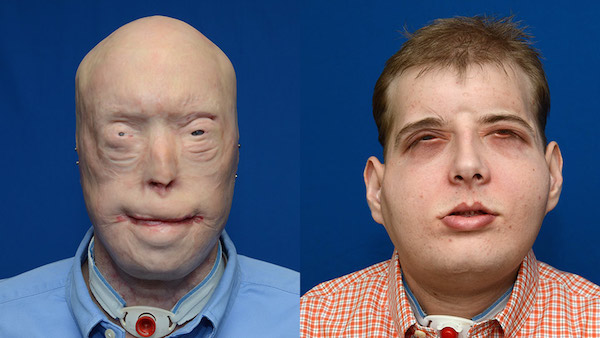Face Transplants Move Forward with Most Extensive Operation Yet

A 41-year-old man who suffered extensive facial burns in 2001 while working as a volunteer firefighter now has a new face. The man recently underwent the most extensive facial transplant done to date, said the doctors who treated him.
Surgeons at New York University Langone Medical Center operated for 26 hours in August 2015. The team included over 100 individuals, said Dr. Robert Grossman, the dean and CEO of the medical center, speaking at press conference today (Nov. 16).
This surgery is historic, said Dr. Eduardo Rodriguez, a plastic surgeon at the center, who led the operation. [The 9 Most Interesting Transplants]
"The amount of tissue that was transplanted [in this surgery] had not been transplanted before," Rodriguez said. He noted that he had only performed one facial transplant procedure prior to this surgery (that earlier operation was the first to successfully transplant bone and teeth).
Prior to this surgery, Rodriguez told the patient, Patrick Hardison, that the surgery had a 50/50 chance of success, Rodriguez said.
After his accident, Hardison had no normal tissue in his face, scalp, eyelids, nose or lips, Rodriguez said. Hardison had also lost his ears, the doctor said. Hardison wore a baseball cap, sunglasses and prosthetic ears to conceal his appearance, and because of significant scarring on his face, he experienced enormous pain when making facial expressions and chewing.
The surgeons planned out the extensive surgery down to the minute, Rodriguez said.
Get the world’s most fascinating discoveries delivered straight to your inbox.
The operation began on the morning of Aug. 12, Rodriguez said. Two teams began working simultaneously, one team working to remove the donor face, and the other to prepare Hardison to receive the transplant.
Removing the donor face took 12 hours, Rodriguez said. The donor's entire scalp, face and eyelids were removed, as well as some bones in the face and chin, which would help provide facial definition, Rodriguez said. In addition, the doctors identified important blood vessels and nerves that would need to be preserved and re-attached when the face was transplanted, he said. The surgeons paid special attention to the functional structures of the eyelids, he added.
The surgery to prepare Hardison to receive the transplant took 8 hours, during which time the team removed all of the scar tissue of Hardison's face, scalp, eyelids and ears, Rodriguez said. It was important to remove all of the man's scars and get down to healthy tissue, Rodriguez said.
The surgeons also removed some of the bones from Hardison's face, because bones from the donor's face would be brought in to replace them, Rodriguez said.
On the morning of Aug. 15, the two surgical teams came together for 10 hours of surgery, Rodriguez said. They attached the bones in the chin, followed by the bones in the middle of the face, he said. The surgeons then re-attached the blood vessels, so that new blood could flow to the transplant, he said. Next, the surgeons focused on the eyelids, followed by the lining of the nose and mouth, before completing the surgery, he said.
"From an overall standpoint, [Hardison is] doing great," Rodriguez said. His recovery is going well and he has had no issues with tissue rejection, a major concern for transplant patients, Rodriguez said.
Hardison was able to move his eyelids several days after the surgery, and began to grow hair within about one month, Rodriguez said.
The doctors felt very positive when Hardison's eyelids starting moving, Rodriguez said. This was the primary purpose of this face transplant, he said.
We now know that we can transplant eyelids, Rodriguez said. This provides great hope for individuals who have lost their eyelids but still have their vision, he said.
Shortly after the surgery, he said, "You could see that [Hardison] was concerned to look in the mirror. Now that he has a new face, he's happy with it," Rodriguez said. "It's his face, as he says it," Rodriguez added.
Hardison still faces many challenges, both physical and psychological, to overcome after his surgery. But Rodriguez told of one important moment, when he took Hardison to Macy's to buy new clothes —Hardison became emotional when he realized that no one was staring at him, Rodriguez said.
Follow Sara G. Miller on Twitter @SaraGMiller. Follow Live Science @livescience, Facebook & Google+. Originally published on Live Science.



